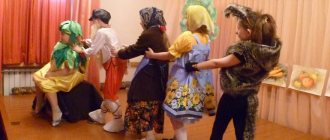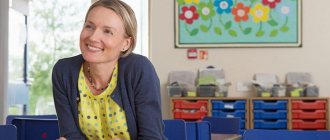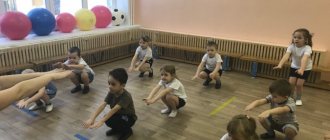Senior group. Senior preschool age. Children 5-6 years old
Summary of a master class for children and parents on making a New Year's ball from threads (senior group) Purpose: 1) to attract parents to joint creativity with their children; 2) introduce parents and children to the technology of making a New Year’s ball from threads; 3) create a pre-New Year mood in the process of making toys. Progress of the master class: Stages Activities of the teacher Activities…
Summary of the parent meeting in the senior group “Health Academy” Goal: Ensuring close cooperation and uniform requirements of the kindergarten and family in matters of preserving and strengthening the health of children. Objectives: 1. To acquaint parents with the content of physical education and health work in groups and kindergartens . 2.Increase the level of parental in...
Parent meeting in the preparatory group Topic: “Readiness of the child’s speech for school”
Parent meeting in the preparatory group
Topic: “Child’s speech readiness for school”
Target:
reveal the importance of speech in the comprehensive development of a child’s personality.
Objectives:
- to acquaint parents with the peculiarities of speech development of a child of senior preschool age, methods and techniques of its development;
— introduce the technology of intelligence cards and speech games, which are useful to play with your child at home;
- involve parents in the pedagogical process and the life of the group.
Participants: parents, educators, speech therapist. Venue: group room.
Progress of the meeting:
- Good evening, dear parents! We thank you for taking the time and coming to meet us. We are glad to see you all. This means that we are all united by an interest in the topic of parent-teacher conferences, and it really deserves attention.
So, the topic of our meeting is “Readiness of a child’s speech for school”
It is known that well-developed speech opens up great opportunities for the mental and intellectual development of a child. If a child speaks in accordance with age standards, his horizons broaden and his knowledge about the world around him is enriched. He can express his thoughts coherently, which allows him to fully communicate with others. Modern parents understand that in the age of technology, live communication is often replaced by gadgets. Therefore, they are concerned with the question of how to ensure the full development of their baby? What reasons influence the appearance of speech problems?
Psychologists say that preschool children entering school often have speech problems that prevent them from learning successfully. The most serious of them are:
- monosyllabicity and inexpressiveness of speech constructed from elementary sentences;
— stinginess of vocabulary;
— use of slang words, non-literary phrases;
- inability to convey the content of the text in your own words;
- slurred diction;
- low literacy (incorrectly placed accents, errors in case endings, incorrectly chosen gender of nouns).
If a preschooler does not have a speech pathology, then the cause of such problems, according to experts, is the behavior of adults surrounding the child, who:
— they communicate little with the child, communication itself comes down only to satisfying needs related to food, hygiene, and routine;
— prohibitions are introduced: “don’t bother me, I’m busy,” “I don’t have time to play with you,” “mind your own business,” “don’t touch anything without me”;
- in the family they speak in a raised tone, use slang;
- do not attach importance to the fact that the child is constantly busy playing computer games;
- they read little, do not discuss what they read with the baby;
- it is not customary to discuss family events at home;
a meager children's library;
- the child lacks full communication with peers;
— adults believe that attending a kindergarten or group is enough, but it is not necessary to conduct speech classes at home.
You can find many more reasons of this kind that inhibit the development of speech in a preschooler. Parents need to know about them, since they must understand that the speech of adults and the manner of communication in the family serve as a role model for children. It largely depends on them how their baby will talk. The better a child’s speech is developed before entering school, the faster the student will master reading and writing.
Correct speech skills are acquired in the family, but the child spends most of his time in a different environment - in kindergarten. And we are deeply convinced that in order to form a full-fledged, harmonious speech development, mutual understanding and interaction between teachers working with the child and the family raising him are necessary.
How should the components of the speech system be developed by the time a child enters first grade? And what should a child be taught during preschool age?
Formation of sound culture of speech.
Normally, the entire sound aspect of speech should be fully mastered by the child by the age of 5–6 years.
By the age of 6-7 years, a child should be able to:
- distinguish sounds by ear and pronunciation;
- hear and highlight the first and last sounds in a word;
- determine the position of a sound in a word (beginning, middle, end);
- determine the number and sequence of sounds in a word;
- name words with a given sound;
— determine the number of syllables in a word, select pictures with a given number of syllables;
- be able to form words from sounds.
When coming to school, a child must clearly pronounce sounds in various words, in phrasal speech, and must not omit them, distort them, or replace them with others.
Enrichment of vocabulary.
The child’s vocabulary increases intensively with speech activity and familiarization with the world around him. Vocabulary can be active or passive. The active vocabulary includes words used in speech and writing, and the passive vocabulary includes words that a person recognizes when reading and listening, but does not use in speech or writing. As a rule, the passive vocabulary exceeds the active one several times. By the age of 7, a child should have a fairly large vocabulary of up to 3,500 words.
— Actively use all parts of speech (nouns, adjectives,
verbs, adverbs).
- Select synonyms, antonyms, homonyms.
— Understand the figurative meaning of words (proverbs, phraseological phrases).
— Select generalizing concepts for a group of subjects.
— Possess word-formation skills to form adjectives from nouns.
Formation of the grammatical structure of speech.
In older preschool age, a child should have grammatically correct speech:
- use various methods of inflection and word formation (table - table, carpet - rug, cherry jam, pineapple juice - pineapple);
- form and use singular and plural nouns in speech (ear - ears, leaf - leaves, many pencils, fox stumps)
;
- coordinate nouns with adjectives (brown skirt, brown coat), numerals with nouns (one egg, two boots), correctly use relative and possessive adjectives in speech (fox tail, bear ear)
,
- be able to use not only simple, but also complex prepositions, etc. (from under the table, from behind a tree)
.
Development of coherent speech.
A child’s coherent speech is the result of his mastery of all aspects of his native language: phonetics, vocabulary, grammar. The requirements imposed by elementary schools on the level of development of coherent speech of a first-grader are very high, since during the lesson he must be able to retell what he has read, tell how he solved this or that problem. By the age of 7, a child must be able to:
— retell short stories and fairy tales of 8–10 sentences, maintaining consistency and meaning;
- compose a story based on a plot picture, from personal experience;
- compose a story based on a series of 3 – 6 plot pictures;
- answer questions based on the text.
When retelling (story), attention is drawn to:
- on structuring the text (he must be able to consistently and accurately construct a retelling);
- on vocabulary (completeness and accuracy of use of words);
- grammar (he must construct sentences correctly, be able to use complex sentences);
— on the child’s understanding of the text (he must correctly formulate the main idea)
The development of intonation expressiveness of speech plays a major role in the development of children’s speech. Children master intonation expressiveness by the age of five. But, as a rule, in kindergarten, when learning poems, songs,
During dramatizations, we are faced with the monotony and inexpressiveness of children's speech. In most cases, this is due to the fact that children do not always realize the importance of intonation in conveying the meaning of statements and their attitude to what is happening. When reading works to children, pay attention to the expressiveness and pace of your speech, explain to the child that intonation helps to accurately convey your thoughts and feelings, and attitude towards other people.
Speech communication
The culture of communication involves the child’s compliance with the norms and rules of communication with adults and peers, based on respect and goodwill, the use of appropriate vocabulary and forms of communication, as well as polite behavior in public places and everyday life. The child must be quite active in communication, be able to listen and understand speech, build communication taking into account the situation, easily come into contact with children and adults, express his thoughts clearly and consistently, and use forms of speech etiquette.
2. Speech by a speech therapist
Exercises for the development of
phonemic analysis and synthesis
1. Determining the number of sounds in a word and their sequence. (How many sounds are in the word “faucet”? Which one is 1,2, 3, 4?),
2. Coming up with words with a certain number of sounds.
3. Recognition of words presented to the child in the form of sequentially pronounced sounds. (What word will come from these sounds: k-o-sh-k-a).
4. Formation of new words using “increasing” sounds. (What sound should be added to the word “mouth” to make a new word? Mole-grot, steam-park, Olya-Kolya, Tolya, Fields).
5. Formation of new words by replacing the first sound in a word with some other sound (Dom-som, crowbar, lump, Tom, crowbar).
6. Formation of as many words as possible from the sounds of a given word, TRACTOR - cancer, so, mouth, rock, current, cat, who, company, bark, cake, court, mole, tact, tract.
7. Select pictures whose titles contain 4-5 sounds.
8. Insert the missing letters into the words: vi.ka, di.an, ut.a, lu.a, b.nocle, etc.
9. Choose words in which the given sound would be in 1st, 2nd, 3rd place (fur coat, ears, cat).
10. Compose words of different sound-syllable structure from the letters of the split alphabet: himself, nose, frame, fur coat, cat, bank, table, wolf.
11. Select words with a certain number of sounds from the sentences, name them orally and write them down.
12. Add a different number of sounds to 1 and the same syllable to get the word: pa-par, pa-park, pa-par, pa-sails.
13. Choose words for each sound. The word is written on a piece of paper. For each letter, choose a word that begins with the corresponding sound. Words are written in a certain sequence: first words with 3 letters, 4, 5, etc.
PEN
Ulya's mouth chas cat Anya
rose corner bowl porridge stork
sleeve street cover cork aster
14. From the written word, form a chain of words in such a way that each subsequent word begins with the last sound of the previous word: house-mac-cat-axe-hand.
15. Dice game. Children throw a cube and come up with a word consisting of a certain number of sounds in accordance with the number of dots on the top face of the cube.
16. Riddle word. Write 1 letter of the word and put dots in place of the remaining letters. If the word is not guessed, the 2nd letter is written, etc.
P . . . . . . . . . . (yogurt).
Exercises for the development of
syllabic analysis and synthesis
1. Determining the number of syllables in a word and their sequence (How many syllables are in the word “hammer”? What is 1? 2? 3?).
2. The child comes up with words with a certain number of syllables.
3. Composing words from syllables given separately. (The syllables have lost their place, we need to help them find it: na-ro-vo, tok-lo-mo, ka-sum).
4. Recognition of words presented to the child in the form of sequentially pronounced syllables. (What word comes from the syllables: go-lo-va).
5. Formation of new words by the child adding syllables to a given word. (Which syllable should be added to the word “gender” to make a new word?).
6. Rearranging syllables in a word to get a new word. (Get a new word by swapping syllables).
7. Distribution of pictures according to the number of syllables in a word. (Put pictures whose names consist of one-syllable words in one place, and whose names consist of 2,3,4-syllable words in another).
8. Clap or tap out the word syllable by syllable and name their number.
9. Identify vowel sounds. (As many syllables in a word as there are vowels).
10. Name the vowels in the word. Words are selected whose pronunciation does not differ from their spelling (puddle, saw, crowbar, ditch).
11. Write down the vowels of this word.
12. Select 1 syllable from the names of the pictures and write it down. By combining the syllables into a word or sentence, read the resulting word or sentence. Beehive, house, car, moon, toad There is a puddle near the house.
13. Identify the missing syllable in a word using a picture: - buz, ut-, lod-, ka-, ka-dash.
14. Select from a sentence words consisting of a certain number of syllables.
Exercises for the development
of language analysis and synthesis
1. Determining the number of words in a sentence and their sequence. (How many words are in the sentence “Vova is reading a book”? What is 1? 2? 3?).
2. Coming up with sentences consisting of a certain number of words.
3. Coming up with sentences based on the plot picture and determining the number of words in it.
4. Composing sentences from words given separately, or working with the so-called deformed text. (The words have lost their place, we need to help them find it: children, ball, in, played; tall, grow, forest, pine, in.)
5. Spreading sentences by increasing the number of words.
Children 6 years old can already talk about the events of their own lives, about their personal experiences, and do this very expressively. Try giving them the creative activities below.
"Remember the incident."
Choose an event with your child that you recently participated in together. For example, how you walked along the embankment and watched the fireworks, met your grandmother at the station, celebrated a birthday... Take turns telling each other what you saw, what you did. Remember as many details as possible until you can no longer add anything to what was said.
"We speak differently."
Try to read the same children's rhyme first in a normal voice, then very quickly and very slowly, in a bass and thin voice, emphasizing the wrong words. By changing the intonation, you can read a harmless poem like a scary story or like a television report. If possible, try using a foreign accent. You never know what you can think of!
"Travel agency".
Every day you and your child go along the usual route - to the store or kindergarten. What if you try to diversify your everyday life? Imagine that you are leaving on an exciting journey. Discuss with your child what type of transport you will use, what you need to take with you, what dangers you will encounter along the way, what sights you will see... While traveling, share your impressions.
"Always at hand."
All parents are familiar with situations when it is difficult to keep their child occupied with something, for example, a long wait in line or a tiring trip on public transport. In such cases, all that is needed is for mom to have a couple of markers or at least just a pen in her purse. Draw faces on the baby’s fingers: one is smiling, the other is sad, the third is surprised. Let there be two characters on one hand, and, say, three on the other. The kid can give the characters names, introduce them to each other, sing a song or act out a scene with them.
"Best friend".
If you're waiting in a room with magazines, you can play "best friend stories." Let the child choose the picture he likes. It could be a person - big or small - or an animal. Ask him to talk about his “best friend.” Where does he live? What games does he like to play? Is he calm or does he like to run? What else can you tell about him?
"Stories from pictures."
It’s good if you can pick up several pictures related to a common plot. For example, from a children's magazine (like Funny Pictures). First, mix these pictures and invite your child to restore order so that they can make up a story. If your child has a hard time at first, ask a few questions. If you don’t have such a set of plot pictures at hand, just take a postcard. Ask your child what it depicts, what is happening now, what could have happened before, and what will happen later.
"Life Stories".
Children enjoy listening to stories about what happened when they were very small or when they were not in the world at all. You can tell these stories in the evening before going to bed, or you can tell them in the kitchen, when your hands are busy and your thoughts are free. What to talk about? For example, how the baby kicked his legs in your stomach when he was not yet born. Or how you learned to ride a bike. Or how dad flew an airplane for the first time... Some stories you will have to tell more than once. Ask other family members to join the game.
"My report."
You and your child went on some trip just the two of you, without other family members. Invite him to write a report about his trip. Use photographs or videos as illustrations. Give your child the opportunity to choose what to talk about, without leading questions. And you observe what exactly was deposited in his memory, what turned out to be interesting and important for him. If he starts fantasizing, don't stop. The baby’s speech develops regardless of what events - real or fictitious - are reproduced to him.
«Family talk show."
Maybe your child will like the idea of trying himself as a television presenter? Prepare a tape recorder or voice recorder for recording, give the “journalist” a microphone - and you can start an interview with your grandmother or grandfather, aunt or sister... Before the interview begins, tell your child what questions to ask. For example: “What is your favorite dish?.. What did you like to eat as a child?.. Where would you like to go?” etc.
"Change the song."
Children like to sing about familiar things - about themselves and their family, about their toys and what they saw on a walk... Choose a well-known song and invite the child to come up with new words for it. It’s okay if the text is not too coherent, a lot of repetition is also not a problem. Rhymes are not required. You can also offer your own, “adult” version of the revised text.
“How did it end?”
One way to develop coherent speech can be watching cartoons. Start watching an interesting cartoon with your child, and at the most exciting point, “remember” the urgent matter that you must do right now, but ask the child to tell you later what will happen next in the cartoon and how it will end. Don't forget to thank your narrator!
Speech therapist advice
1. Do not try to speed up the child’s natural speech development. Don't overload him with speech activities. Games, exercises, speech material must be age appropriate.
2. When communicating with a child, watch your speech. Talk to him slowly. Pronounce sounds and words clearly and clearly; be sure to explain incomprehensible words and phrases found in the text.
3. Do not imitate children's speech, do not abuse diminutive suffixes - all this inhibits speech development.
4. Correct the child’s speech deficiencies in a timely manner, trying to point out inaccuracies and errors found in his speech, be careful, do not laugh at the baby under any circumstances, the best thing is to tactfully correct this or that word if the child is in a hurry to express his thoughts or speaks quietly , remind him: “You need to speak clearly, clearly, and slowly.”
5. Don’t leave your child’s questions unanswered. And don’t forget to check: “Does he understand your answer?” If you have a tape recorder in the house, record your child's speech. Such recordings will not only help in working on speech, but over time will be a good gift for a son or daughter.
So, armed with all this knowledge, you will find your way to school easier. However, remember: the most important thing for a first-grader is not skills and abilities, but confidence in one’s abilities and in parental support, no matter what happens at school. Good luck!
3. Master class on making mind maps.
With the introduction of Federal State Educational Standards in preschool education, there is a need to search for new means, various educational technologies and methods that contribute to the acquisition by preschoolers of such personality traits as: curiosity, independence, activity, initiative, as well as cognitive development.
One of these technologies is the method of creating mind maps, which ensures high cognitive activity of children in various types of activities, and promotes the interaction of children with adults and peers.
This method was proposed and developed by the English psychologist Tony Buzan.
The concept of mind maps is based on the peculiarities of information perception by the human brain. The fact is that it is difficult for the brain to perceive symbolic information in the form of texts and tables. It is much easier for the consciousness to digest information that is based on associations, involves hierarchical thinking, is visualized, supplemented with color and pictures in accordance with associations.
Mind maps came to the world of preschool technologies thanks to Ph.D. V.M. Akimenko, who proposed using this method for the development of coherent speech in children.
A mind map is a unique and simple method of memorizing information with the help of which both the creative and speech characteristics of children develop and their thinking is activated.
K.D. Ushinsky wrote: “Teach a child some unknown five words, he will suffer for a long time and in vain, but connect twenty such words with pictures, and he will learn on the fly.”
The mind map method is based on the child’s visual-figurative thinking, which is fundamental in preschool age. The use of such maps encourages the child to depict and comprehend the world around him.
There are rules for compiling mind maps:
· When working, only colored pencils, markers, felt-tip pens, etc. are used.
· The sheet is positioned horizontally.
· The main idea is outlined in the center of the page (you can use drawings and pictures to depict it).
· For each keyword, branches diverging from the center are drawn (in any direction)
· Each main branch has its own color.
· One keyword is written above each line-branch.
· You must write legibly, in block letters.
· For better memorization and assimilation, it is advisable to use drawings, pictures, associations about each word.
Practical part of the master class
Now we will create a mind map together.
-I offer you the key idea “Sounds”. Let's draw an oval in the middle of the sheet and write the name of our idea in it.
-Draw a thick red line from it. The sounds are vowels, and they, in turn, are stressed and unstressed. From the word vowels we draw two thin red lines in different directions and sign them.
-There are consonant sounds. We draw a thick black line from the key idea and sign it.
-Consonant sounds are soft and hard. From the word “consonants” we draw green and blue lines and sign them.
- Consonants can be voiced or unvoiced. From the word “consonants” we draw thin black lines and sign them.
-If you make such a map together with your child, you can use symbols and drawings instead of words.
— Dear parents, now we will be divided into 2 groups, each group receives a sheet of paper, markers, pictures and an instruction card. We will try to make an intelligence map with you.
The first group covers the topic “Clothing”, and the second - “Animals”
All teams complete tasks.
Next, each group presents their work.
These are the interesting mind maps we have created for you.
The main advantage of the method is its versatility, and the fact that the technique is very simple and can be used by any of you. And we see that the map will help the child remember all the information more easily.
Concluding the conversation about the need for speech preparation of children for school , I would like to emphasize that the richer and more correct a child’s , the wider his capabilities, the more complete his relationships with children and adults. Conversely, a child’s greatly complicates his relationships with peers, often leaves an imprint on the child’s , and interferes with successful learning at school .
And finally, I would like to wish you: “Love your children and help them. Children are the most precious thing you have!”
Thank you very much for taking part in our conversation today. Please leave feedback about our meeting today.
Thank you for your attention, goodbye!
Parent meeting decision:
1. Use the knowledge gained at the parent-teacher meeting in the development of children’s speech.
2. Continue to improve the psychological and pedagogical competence of parents regarding the peculiarities of the child’s speech development.
3. Pay attention to the issues of reading fiction at home with children.




